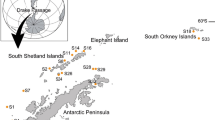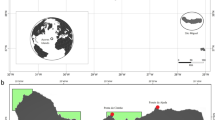Abstract
Organisms boring into fifty nine species of gastropod shells on reefs around Guam were the bryozoan Penetrantia clionoides; the acrothoracian barnacles Cryptophialus coronorphorus, Cryptophialus zulloi and Lithoglyptis mitis; the foraminifer Cymbaloporella tabellaeformis, the polydorid Polydora sp. and seven species of clionid sponge. Evidence that crustose coralline algae interfere with settlement of larvae of acrothoracian barnacles, clionid sponges, and boring polychaetes came from two sources: (1) low intensity of boring in limpet shells, a potentially penetrable substrate that remains largely free of borings by virtue of becoming fully covered with coralline algae at a young age and (2) the extremely low levels of boring in the algal ridge, a massive area of carbonate almost entirely covered by a layer of living crustose corallines. There was a strong negative correlation between microstructural hardness and infestation by acrothoracian barnacles and no correlation in the case of the other borers. It is suggested that this points to a mechanical rather than a chemical method of boring by the barnacles. The periostracum, a layer of organic material reputedly a natural inhibitor of boring organisms, was bored by acrothoracican barnacles and by the bryozoan. The intensity of acrothoracican borings is shown to have no correlation with the length of the gastropod shell.
Similar content being viewed by others
References
Bertram GCL (1936) Some aspects of the breakdown of coral at Ghardaga, Red Sea. Proc Zool Soc London 106:1011–1026
Boekschoten GJ (1966) Shell borings of sessile epibiontic organisms as palaeoecological guides (with examples from the dutch coast). Palaeogeogr Palaeoclimatol Palaeoecol 2:333–379
Bøggild OB (1930) The shell structure of the mollusks. K Dan Vidensk Selsk Skr Natruvidensk 2:233–326
Bottjer DJ (1981) Periostracum of the gastropod Fusitriton oregonensis: natural inhibitor of boring and encrusting organisms. Bull Mar Sci 31:916–921
Bromley RG (1978) Bioerosion of Bermuda reefs. Palaeogeogr Palaeoclimatol Palaeoecol 23:169–197
Cernohorsky WO (1978) Tropical Pacific Marine Shells. Pacific Publications, Sydney
Clark GR (1976) Shell growth in the marine environment: approaches to the problem of marginal calcification. Am Zool 16:617–626
Cobb WR (1969) Penetration of calcium carbonate substrates by the boring sponge Cliona. Am Zool 9:783–790
Costlow JD, Tipper RC (1984) Marine biodeterioration: an interdisciplinary study. Naval Institute Press, Annapolis
Crisp DJ (1984) Overview of research on marine invertebrate larvae, 1940–1980. In: Costlow JD, Tipper RC (eds) Marine biodeterioration: an interdisciplinary study. Naval Institute Press, Annapois, pp 103–126
Currey JD (1976) Further studies on the mechanical properties of mollusc shell material. J Zool London 180:445–453
Currey JD, Taylor JD (1974) The mechanical behaviour of some molluscan hard tissues. J Zool London 173:395–406
Curry GB (1983) Microboring in recent brachiopods and the functions of caeca. Lethaia 16:119–127
Hansen JC (1970) Commensal activity as a function of age in two species of california abalones (Mollusca: Gastropoda). Veliger 13:90–94
Hartman O (1941) Some contributions to the biology and life history of Spionidae from California. Hancock Pacific Exped 7:289–322
Hartman WD (1957) Ecological niche differentiation in the boring sponges (Clionidae). Evolution 11:294–297
Highsmith RC (1981) Coral bioerosion at Enewetak: agents and dynamics. Int Rev Hydrobiol 66:335–375
MacGeachy JK (1977) Factors controlling sponge boring in Barbados reef corals. Proc 3rd Int Coral Reef Symp 2:477–483
MacGeachy JK, Stearn C (1976) Boring by macro-organisms in the coral Montastrea annularis on Barbados reefs. Int Rev Hydrobiol 61:715–745
Milliman JD (1974) Marine carbonates. In: Milliman JD, Muller G, Forstner U (eds) Recent sedimentary carbonates. Springer, Berlin Heidelberg New York, pp 1–375
Morse ANC, Morse DE (1984) Recruitment and metaborphosis of Haliotis larvae induced by molecules uniquely available at the surfaces of crustose red algae. J Exp Mar Biol Ecol 75:191–215
Orrhage L (1969) On the shell growth of Littorina littorea (Linne) (Prosobranchiata, Gastropoda) and the occurrence of Polydora ciliata (Johnston) (Polychaeta Sedentaria). Zool Bidr Uppsala 38:137–153
Pomponi SA (1980) Cytological mechanisms of calcium carbonate excavation by boring sponges. Int Rev Cytol 65:301–319
Risk MJ, Sammarco PW (1982) Bioerosion of corals and the influence of damselfish territoriality: a preliminary study. Oecologia 52:376–380
Rützler K, Rieger G (1973) Sponge burrowing: fine structure of Cliona lampa penetrating calcareous substrata. Mar Biol 21:144–162
Smyth MJ (1988a) Penetrantia clionoides, sp. nov. (Bryozoa), a boring bryozoan in gastropod shells from Guam. Biol Bull 174:276–286
Smyth MJ (1988b) The foraminifer Cymbaloporella tabellaeformis (Brady) bores into gastropod shells. J Foraminiferal Res 18:277–285
Smith MJ (1990) Incidence of boring organisms in gastropod shells on reefs around Guam. Bull Mar Sci 46 (in press)
Snedecor GW, Cochran WG (1967) Statistical methods, 6th edn. Iowa State University Press, Ames, Iowa
Srinivasan PS (1941) The elastic properties of molluscan shells. Q J Indian Inst Sci 4:189–221
Warburton FE (1958) Control of the boring sponge on oyster beds. Progress Reports of the Atlantic Coast Stations. Fish Res Board Can 69:7–11
Warburton FE (1966) The behavior of sponge larvae. Ecology 47:672–674
Wells HW, Tomlinson JT (1966) A new burrowing barnacle from the western Atlantic. Q J Florida Acad Sci 29:27–37
White F (1969) Distribution of Trypetesa lampas (Cirripedia, Acrothoracica) in various gastropod shells. Mar Biol 4:333–339
Woodwick KH (1963) Comparison of Boccardia columbiana Berkeley and Boccardia proboscidea Hartman (Annelida, Polychaeta). Bull S Calif Acad Sci 62:132–139
Yonge GM (1955) Rock-boring organisms. In: Sognnaes RF (ed) Mechanisms of hard tissue destrution, publ 75. Am Assoc Adv Sci, Washington, DC, pp 1–24
Author information
Authors and Affiliations
Rights and permissions
About this article
Cite this article
Smyth, M.J. Bioerosion of gastropod shells: with emphasis on effects of coralline algal cover and shell microstructure. Coral Reefs 8, 119–125 (1989). https://doi.org/10.1007/BF00338267
Accepted:
Issue Date:
DOI: https://doi.org/10.1007/BF00338267




